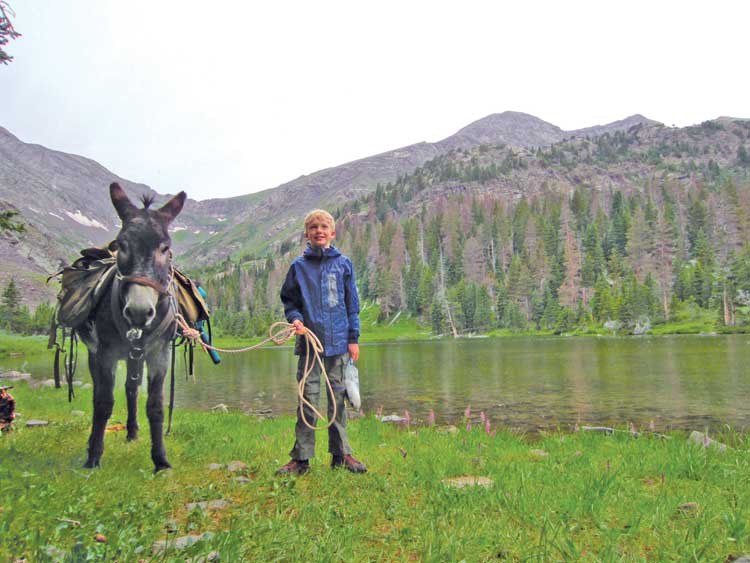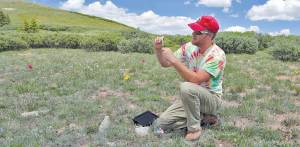By Hal Walter
I looked up at Music Pass and could see the dark clouds of the season’s first serious storm brewing, threatening snow or freezing rain up there at over 11,000 feet. I looked at my friends. We’d planned a burro pack trip over the pass and down the other side. It was September, and anything is possible. I just didn’t have a real good feeling about it.
“I know another place,” I said.
And so we got back into our vehicles and backtracked several miles to another trailhead. From here we could catch the Rainbow Trail for about a mile, then turn up a narrow valley that led to a lake.
I’d scouted this valley out before. Few people venture up it, preferring instead the more popular lakes just out of the trailhead. About a mile up the trail, there is a large meadow with a rushing stream meandering along its edge. It makes a great lower campsite. And from there it’s just a short three-mile hike up to the lake.
We pitched our camp there and waited to see what the next day’s weather would bring. If it was snow we could easily bail. But it didn’t snow. The day broke bright and we made our way on up to the Wingood Lake.
This was the first of many trips into Wingood; it remains one of the least visited in the Sangres, whichmay explain why it’s one of my favorite places. There is the notion that wilderness – wildness – is where lies the preservation of the world. Thoreau, etc. That people can find comfort in the idea of the mere existence of places like this, regardless of whether they ever go there. Or in my case, go there several times.
The Wingood trail is one of the most amazing in the range, punctuated by steep rocky pitches, meandering along the rushing creek, passing through spruce stands where beards of green moss hang from the trees; and in summer it’s lined with wildflowers of many varieties, including some of the thickest patches of columbines I’ve seen. Despite the surrounding steep slope angles, the ground seems so level at this lake that one wonders what’s keeping the silvery water from pouring out over its banks and onto the surrounding landscape. On a still day the high ridges and peaks are reflected on its surface like a mirror. Above, a ribbon of a stream cascades down a series of falls.
One early October, my friend Craig Schreiber from Leadville and I camped near this lake’s shore for two sunny days and witnessed an amazing freshwater shrimp hatch that tinted the shallow banks orange along the edge. On that trip Craig bagged nearby Eureka Peak, and I climbed up a ridge to look over into the Eureka Lake basin. From this perch I could look directly down on that lake and see trout squiggle up from the depths to grab insects off the surface and then dive straight back down to disappear in the deep water.
By contrast Wingood Lake is quite shallow, and I’ve often marveled that winter cold doesn’t freeze it from top to bottom and kill all the fish. One winter I snowshoed into the lake and could see that a part of it actually does not freeze. With an eye on the huge snow cornices on the ridges above the lake, I clambered up to the snowy edge and could see fish in the open water. There were several feet of snow and ice on most of the lake and a fairly steep drop to the open water. As I tried to get a better view of the fish, some of the snow gave way and I slipped off the icy slope. Before I could catch myself, one foot landed in the icy water. I managed to climb back out, thanks to the snowshoe crampons and clawing my way up on all fours. It was an uncomfortable snowshoe out with one wet foot.
Over the years, the trips into the Wingood drainage all seem to blend into one big journey. There was a pack trip with my friend Patrick O’Grady, where we were greeted on the upper end by crackling lightning, then spent a soggy night in our tents. On another trip I camped with friends in the lower meadow; right about dusk I noticed the burros I’d let graze were now missing. I combed the area, then finally took off at a jog with a flashlight figuring they’d headed back to the trailhead. But that proved not to be the case. While sitting around the campfire later I heard a stick crack in the timber above the camp. I made my way with the flashlight into the woods and soon found myself staring at two eyes; I first thought they belonged to a bear, but then I realized I’d found my lost animals.
The year I first won the Fairplay World Championship Pack-Burro Race with Spike, we were perhaps the earliest travelers to the lake that season. Spike was just four, and we had a tremendous tug-of-war at the creek crossing. I would say this is where that burro learned to cross water and I learned just how cold snowmelt is. In yet another year, I was surely the last person to fish the lake that season, and with freezing hands caught a cutthroat and released it to water that would soon be icing over.
 Recently I revisited this place with my son Harrison. He had hiked the lower section of the trail but had never been to the lake. Now 10 and a hiking machine, he could not be stopped. We rambled with Spike through the height of wildflower season, and the memories began to flow. I showed him where that same burro and I had that battle over crossing the creek so many years ago. Now 20 and a veteran of countless backcountry adventures, Spike splashed right on through the creek and two trout retreated to the lower end of the pool. On the other side, we stopped and watched a young marmot that greeted us with a shrill chirp that echoed off the talus.
Recently I revisited this place with my son Harrison. He had hiked the lower section of the trail but had never been to the lake. Now 10 and a hiking machine, he could not be stopped. We rambled with Spike through the height of wildflower season, and the memories began to flow. I showed him where that same burro and I had that battle over crossing the creek so many years ago. Now 20 and a veteran of countless backcountry adventures, Spike splashed right on through the creek and two trout retreated to the lower end of the pool. On the other side, we stopped and watched a young marmot that greeted us with a shrill chirp that echoed off the talus.
The columbines were stunning and when we arrived at the lake, I realized a fair number of big trees on the opposite shore had died since my last visit. The lake was swimming with fish and I soon caught a couple cutthroats for dinner. We packed them on snow and then headed back down the trail. Harrison led Spike the entire way out.
I thought about how so many things had changed in my life since the first time I’d been here, but with the exception of a few dead trees, this place was still very much the same, wild and largely unvisited. Everyone should have a special place like this, a place they can visit and revisit, either in reality, or in the mind.
Hal Walter writes and edits from the Wet Mountains. You can keep up with him regularly at his blog: www.hardscrabbletimes.com



